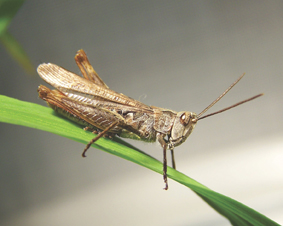A bad songs turns off

A grasshopper of the species Chorthippus biguttulus, which the scientists examined in the study. Copyright: Monika Eberhard, 2014
Which mating partner is the best? To answer this difficult question, female grasshoppers base their decision on the singing skills of their male conspecifics. In the process, the quality of bad singers has much bigger weight than the one of good singers.
The latter has a negligible influence on the decision of females. This is the result of a study by researchers lead by Bernhard Ronacher at the Bernstein Center Berlin and the Humboldt-Universität in Berlin.
The scientists point out that their research results are consistent with current theories of sexual selection: it helps females to avoid time and cost-intensive contacts with unsuitable mating partners—such as with males of other species, which have distinct calling songs.
For the study, the researchers presented female grasshoppers with male calling songs in a sound-isolated chamber. When a female likes a song, it produces a response, which in turn encourages the male in its courtship behavior.
“The animals evaluate song subunits with a more or less constant volume as being most attractive”, explains Jan Clemens, first author of the study. The scientists presented both attractive and non-attractive calling songs to the animals and recorded the female responses to investigate the decision process in the animals.
“We found that especially the beginning of a song has a strong influence on the response of the females,” says Clemens. This could mean that grashopper females are easily coerced into mating with a male after a few good syllables—which contradicts current theories of sexual selection, however. These postulate that females should be choosy and should therefore evaluate well if the males may produce good songs over a longer time period, too.
To unravel the dynamics of decision making in more detail, the researchers analyzed their data using a computational model. This model allowed them to consider further parameters in the analysis of the behavioral data, such as the weight of sensory information in the decision process, or the internal decision threshold of the animal.
“Interestingly, this model provided us with a very different explanation: a bad song has much more weight than a good one during the decision making process. This interpretation is far more consistent with current theories of sexual selection, since it helps to prevent disadventageous mate choices,” says Clemens.
The neuroscientist alludes to the expanded analysis opportunities of computational models. It was the model that helped them to disentangle the behavior of female grashoppers and revealed that the animals are not reacting impulsively to good songs but rather selectively reject “bad” ones.
The Bernstein Center Berlin is part of the National Bernstein Network Computational Neuroscience in Germany. With this funding initiative, the German Federal Ministry of Education and Research (BMBF) has supported the new discipline of Computational Neuroscience since 2004 with over 180 million Euros. The network is named after the German physiologist Julius Bernstein (1835-1917).
Contact:
Prof. Dr. Bernhard Ronacher
Humboldt-Universität zu Berlin
Institut für Biologie
Abteilung Verhaltensphysiologie
Invalidenstraße 43
10115 Berlin
Tel: +49 (030) 2093-8806
Email: bernhard.ronacher@rz.hu-berlin.de
Dr. Jan Clemens
Princeton Neuroscience Institute and
Department of Molecular Biology
A53 PNI
Washington Road
Princeton, NJ (USA) 08544
Tel: +1 (609) 258-7668
Email: clemensjan@gmail.com
Original publication:
J. Clemens, S. Krämer, B. Ronacher (2014): Asymmetrical integration of sensory information during mating decisions in grasshoppers. PNAS, advanced online publication
doi: 10.1073/pnas.1412741111
Weitere Informationen:
https://www2.hu-berlin.de/biologie/vhphys webpage Bernhard Ronacher
http://www.princeton.edu/~janc webpage Jan Clemens
http://www.hu-berlin.de Humboldt-Universität zu Berlin
http://www.bccn-berlin.de Bernstein Center Berlin
http://www.nncn.de/en National Bernstein Network Computational Neuroscience
Media Contact
All latest news from the category: Life Sciences and Chemistry
Articles and reports from the Life Sciences and chemistry area deal with applied and basic research into modern biology, chemistry and human medicine.
Valuable information can be found on a range of life sciences fields including bacteriology, biochemistry, bionics, bioinformatics, biophysics, biotechnology, genetics, geobotany, human biology, marine biology, microbiology, molecular biology, cellular biology, zoology, bioinorganic chemistry, microchemistry and environmental chemistry.
Newest articles

After 25 years, researchers uncover genetic cause of rare neurological disease
Some families call it a trial of faith. Others just call it a curse. The progressive neurological disease known as spinocerebellar ataxia 4 (SCA4) is a rare condition, but its…

Lower dose of mpox vaccine is safe
… and generates six-week antibody response equivalent to standard regimen. Study highlights need for defined markers of mpox immunity to inform public health use. A dose-sparing intradermal mpox vaccination regimen…

Efficient, sustainable and cost-effective hybrid energy storage system for modern power grids
EU project HyFlow: Over three years of research, the consortium of the EU project HyFlow has successfully developed a highly efficient, sustainable, and cost-effective hybrid energy storage system (HESS) that…





















